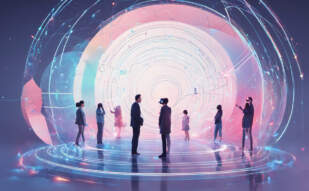Artificial Intelligence (AI) powers Web Augmented Reality (AR) platforms, enabling the creation of hyper-personalized and immersive experiences without requiring app development. AI aids in user profiling, behavior tracking, and data visualization, transforming industries like e-commerce by enhancing customer engagement while adhering to privacy norms.
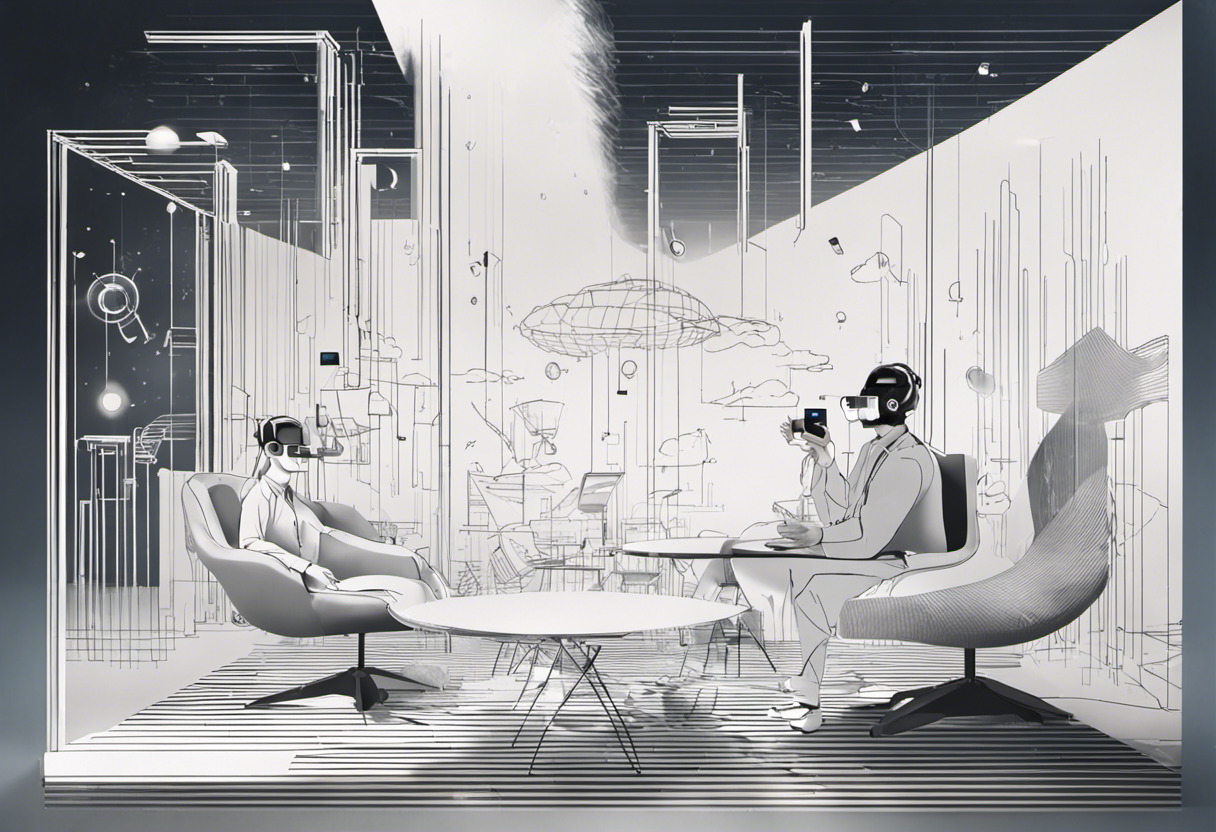
Upon reading this article, you will grasp the integration of AI and AR in creating personalized web experiences and its impact on the e-commerce sector.
Introducing AI Powered Web AR Platforms
As technology advances, the concept of immersive experiences has seamlessly transitioned to the digital landscape. One promising trend at the forefront of this transition is the integration of Artificial Intelligence (AI) with Web Augmented Reality (Web AR). Platforms such as Vossle have become key players in this domain, utilizing AI to create interactive and personalized web AR experiences.
Creating Immersive AR Content with AI
No longer confining AR experiences to the constraints of app development, AI has proved to be game-changing. AI facilitates the creation of more complex and immersive AR content by understanding user behavior and providing personalization. Key features of AI-powered platforms such as Vossle can be highlighted as follows:
- Easy content creation: AI algorithms assist users in creating AR experiences swiftly and without the need of workflow involving coding or understanding technical graphics.
- Personalized experiences: AI algorithms analyze user behavior and preferences to generate custom and highly immersive web AR experiences.

To better understand these capabilities, our complete guide to leveraging AI in Web AR dives deep into the methods and benefits of incorporating AI tools in AR.
Capabilities of AI Powered AR
Platforms that blend AI and AR capabilities contribute significantly to the augmentation of digital experiences. The uniqueness lies in the ability to offer varying degrees of personalization, effectively creating a different experience for each user.
- Object recognition: AI can instantly recognize various objects and images, triggering a suitable AR experience based on the context.
- AR effects: AI algorithms can customize AR effects as per user behavior and preferences, ensuring each AR experience is tailor-made for the individual user.
- Navigation assistance: Pairing AI with AR, platforms can provide extensive navigation assistance visually, improving user experience extensively.

The amalgamation of AI and AR is not just the future, but the present. The advent of such platforms creates opportunities for developers, marketers and tech enthusiasts to ride the wave of this digital transformation, offering immersive and personalized experiences to end users.

Potential Functions of AI in Personalizing Experiences
In the realm of Web AR, AI plays a critical role in personalization. The fusion of user profiling, behavior tracking, and feedback help tailor AR experiences to individual users. Let’s delve deeper into understanding how AI contributes to this process.
Data Sources and Analysis for AR Personalization
Data is the fuel that powers AI. It feeds on information from various sources to enable personalization in Web AR. The primary focus areas include:
- Data Mining: User data is harvested from multiple sources, analyzed, and used to generate profiles. Striving to mitigate the risk of delivering generic experiences, AI taps into demographics, past behaviour, and preferences.
- Machine Learning: Machine Learning algorithms learn from the data fed to them, enabling them to make predictions based on user patterns. This helps in customizing the AR experience to match the preferences and habits of individual users.
- Computer Vision: This AI technology identifies and interprets visual data, allowing AR applications to interact with the real world in a more meaningful way.

The role of these technologies is fundamental to enabling the AI personalization we see in Web AR. To further delve into the intricacies of the security and privacy that these data interactions involve, visit this enlightening resource on practices for security and privacy in Web AR.
Data Visualization Techniques in Personalizing AR
Combining the power of AI and AR can lead to highly engaging, interactive experiences that are truly personalized. One of the means of achieving this is through data visualization. It allows data to be visually represented within the AR setting itself.
- Interactive Charts: Instead of static charts, users can interact with real-time charts and graphs in their AR environment. This makes data digestion more convenient and immersive.
- AR Dashboards: Users can set up virtual dashboards in the AR space, displaying personalized data in a more engaging and applicable manner.
- Visual Storytelling: Instead of textual constants, visual elements can be used to signify data points, engaging users in a more interactive and memorable fashion.

While these visualization techniques offer enhanced user experiences, they also raise privacy and security concerns. AR and AI both require access to vast amounts of sensitive user data. Ensuring that this data is protected from misuse is crucial to maintaining consumer trust.
Security and Privacy in the Confluence of AI and AR
Entering the era of AI and AR, the impending issues to be addressed include data privacy, security and ethical implications. These concerns are heightened in scenarios where personal data is used not only to make an AR experience better but to also influence user behaviour.
Therefore, it becomes pivotal to communicate transparently with users about the data being collected, its usage, and the steps taken to safeguard it. Machine Learning algorithms dealing with personal data need to follow fairness in their operation, keeping any kind of discrimination at bay. The use of anonymized data, encryption and user-consent for data collection are some strategies that can be employed.
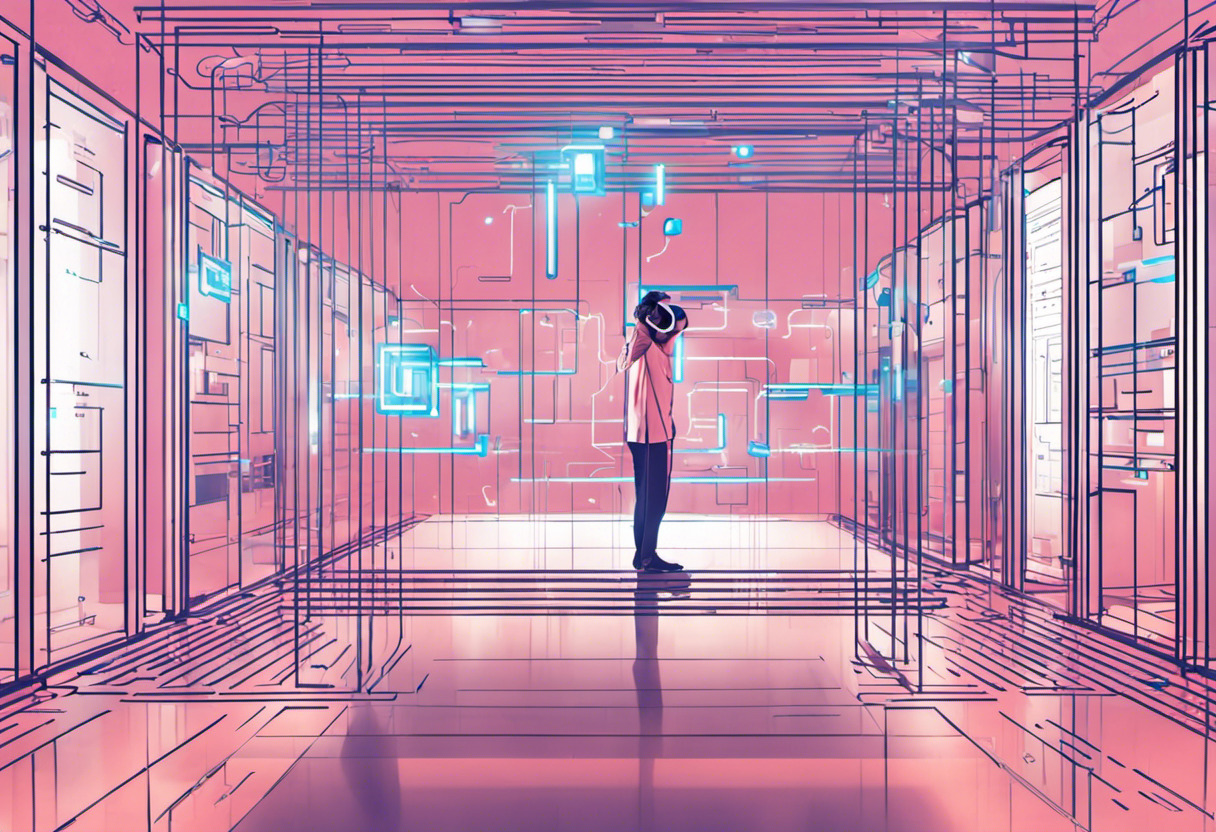
Any instance of laxity in these areas could severely impact user trust and nick the potential of hyper-personalization with AI. This dictates that developers and service providers have rigorous privacy and security protocols in place to ensure the sensitive information they have access to is safe from malicious threats.
Personalizing Web AR with AI, while ensuring user data security sets the foundation for a responsible and immersive future. A more comprehensive discussion on privacy and security considerations can be found in this informative resource mobilizing robust security and privacy measures in Web AR initiatives.
AI’s Role in Transforming E-commerce with Web AR
The digital age continues to reinvent how we shop, and the recent years have seen a remarkable surge in investments within the e-commerce sector to integrate Artificial Intelligence (AI) and Augmented Reality (AR) technologies. The benefits of AR in e-commerce expanded beyond traditional online shopping boundaries to include the ‘try before you buy’ phenomenon. The fusion of AI and AR in this sector heralds unique customer experiences, driving satisfaction numbers like never before.
Brief Overview of AR Benefits to the E-commerce Industry
An eCommerce business can undoubtedly gain from AR’s unique offerings, providing potential benefits such as better customer satisfaction rates and increased sales figures. One of the groundbreaking AR features proving valuable to the eCommerce industry is the ‘try before you buy’ function.
- Customer Previews: AR allows customers to preview products in a real-world context before making a purchase decision. This often includes placing furniture pieces within an existing room or trying clothes on a virtual avatar.
- Enhanced Customer Satisfaction: As consumers gain increased confidence in their desired products, their satisfaction rates are likely to surge, potentially lowering return rates.
- Increased Sales: A significant increase in customer satisfaction and reduced returns is a promising recipe for increased sales.

By fully understanding the perks AR brings to the e-commerce table, the next logical step is to explore the potential of uniting AI with AR to create hyper-personalized experiences for consumers. More details on the benefits of AR for e-commerce.
Fusion of AI and AR in Delivering Customer Experiences
The blend of AR and AI offers a fresh canvas for e-commerce professionals to paint an unparalleled customer journey. The integration shines through its ability to learn and adapt to individual user behaviors. Here are practical ways in which AI and AR improve the eCommerce domain.
- Access to on-demand, contextually relevant data, creating hyper-personalized shopping experiences for consumers.
- The advent of no-code AI platforms, reducing bar entry for eCommerce businesses, and encouraging wider adoption of AI and AR.
- Enables interactive and engaging user experiences, enhancing customer engagement rates and overall brand loyalty.

| Without AI & AR | With AI & AR |
|---|---|
| Limited customer engagement | Highly interactive shopping experiences |
| Consumer dissatisfaction due to mismatch expectations | Increased satisfaction from ‘Try-before-you-buy’ experiences |
| Lower sales conversion rates | Higher sales conversions from personalized shopping |
In conclusion, the unity of AI and AR in eCommerce is not just a passing trend. Customer expectations are evolving rapidly, demanding increased convenience and personalized experiences. The advent of AI and AR in eCommerce indicates a promising future poised to meet and potentially exceed these demands. The power of AI’s personalization in Web AR cannot be understated in this context.

AR and AI Fusion – Elevating Customer Shopping Experience
Artificial Intelligence (AI) and Augmented Reality (AR) are not just buzzwords anymore. They have revolutionized the customer shopping experience in several unique ways. This section will detail how the integration of AI and AR creates immersive, personalized web experiences, and highlight practical applications that are reshaping the retail industry.
Deep Neural Networks: Building Block for Immersive AR Experiences
Deep neural networks – subunits of machine learning models that imitate the human brain’s neural network – play a significant role in crafting realistic, immersive AR experiences. They drive an upgrade in the shopping experience by enabling essential features such as facial recognition, object detection, and behavior prediction.

The potency of deep neural networks lies in their ability to analyze vast and complex datasets, facilitating seamless person-object interaction within the AR environment. With this technology, retailers can tailor-fit each customer’s experience based on their unique preferences, styles, and behaviors.
Let’s outline the sequence by which this AI-driven AR interaction occurs:
- The deep neural network identifies the user’s facial features in real-time.
- It then locates objects within the scene based on previously trained models.
- Finally, the system generates AR content accurately adjusted to the user’s dimensions and scene context.
Bringing It to Life: Real-Time Clothing Swapping and AR Shopping
Understanding the theory of AR and AI integration is one thing; seeing its application brings the concept to life. Real-time clothing swapping and AR shopping are two such practical applications that demonstrate the power of this synergy.
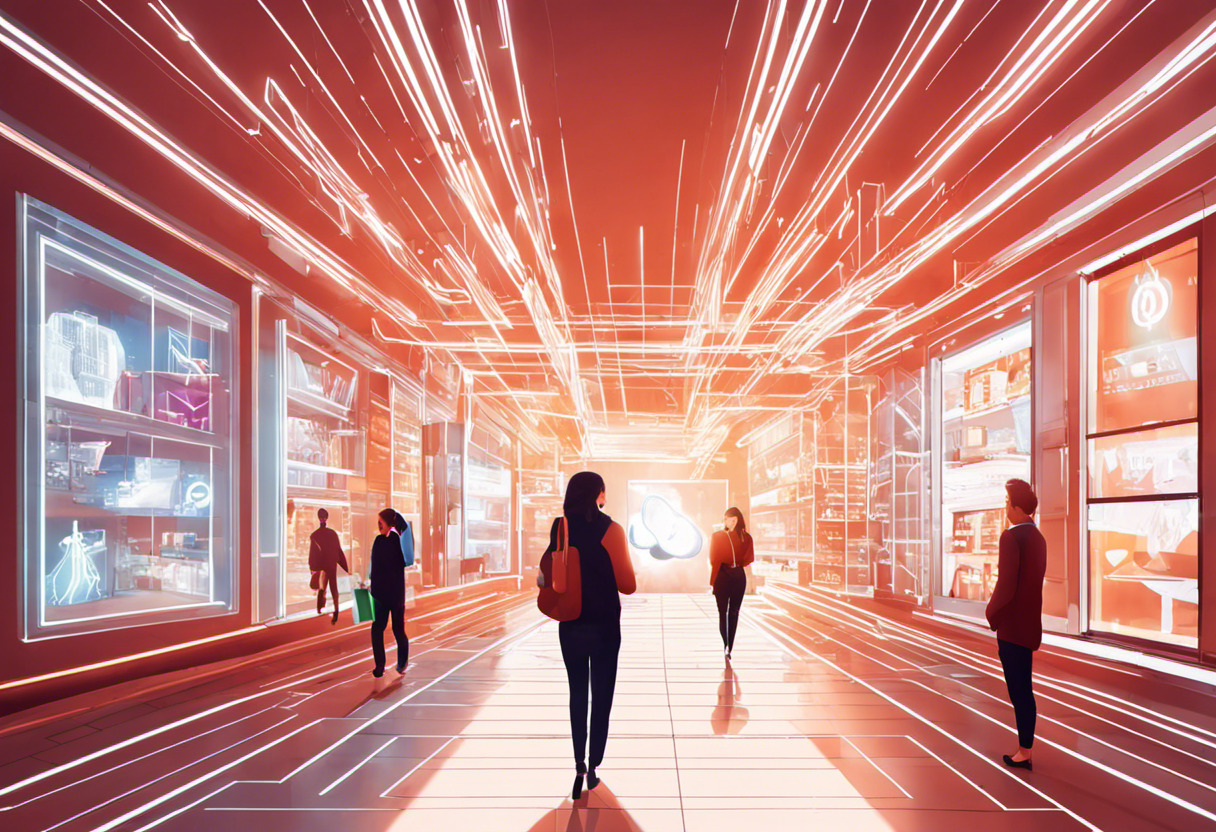
| Applications | Description |
|---|---|
| Real-time clothing swapping | This technology lets online shoppers virtually ‘wear’ different clothes in real-time, just by using their smartphone camera. AI uses body shape and size data to provide accurate fitting information, greatly improving the accuracy of size recommendations. |
| AR shopping | AR-assisted shopping allows customers to virtually place products in their environment before purchase. Combined with AI’s predictive analytics, it can recommend complementary products, design suggestions, and more – all based on the user’s past preferences and habits. |
To delve deeper into how AR can be amplified with QR codes for ultimate consumer experiences, read more about it in this comprehensive exploration on QR Codes enhancing web AR experiences.
In conclusion, the integration of AI with Web AR is revolutionizing the customer shopping experience. It creates a personalized and highly interactive environment that caters specifically to each customer’s unique preferences. As the technology advances, we expect to see even more innovative applications that offer customers an even more streamlined and enjoyable shopping experience.
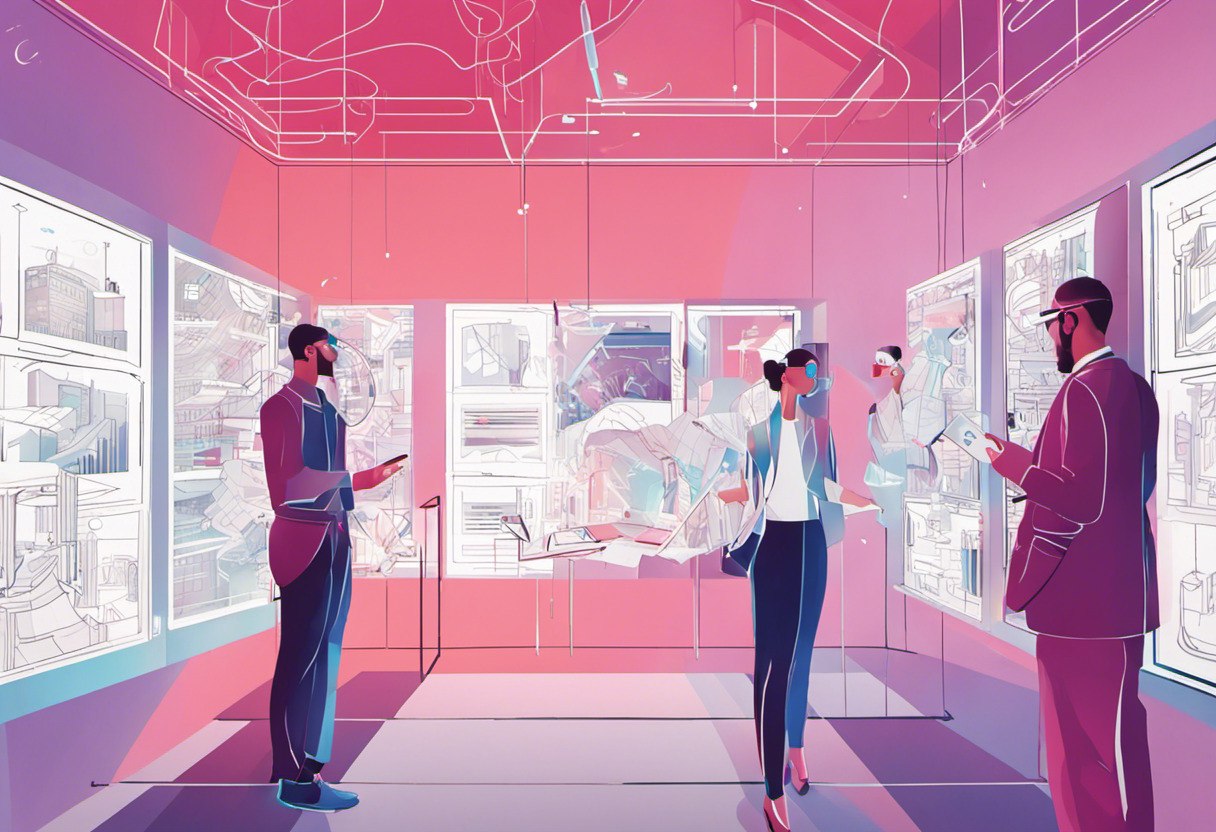
The Future of AI in Web AR
As we delve deeper into the digital era, the integration of AI and AR becomes even more impactful. With the advent of next-generation technology, AI and AR have the power to metamorphosize the marketing industry, spinning off novel strategies that tap into personal customer experiences.
AI and AR Growth in the Marketing Industry

This transformative power of AI in Web AR is tied to two significant trends in the industry: hyper-personalization and no-code AI.
- Hyper-personalization with AI: Traditional personalization strategies might become obsolete as AI and Web AR become increasingly intertwined. AI-backed tools like machine learning carry the capacity to learn from user interactions on the Web AR platform, leading to the creation of more immersive and personalized AR experiences.
- No-code AI: As the name suggests, no-code AI allows users with no programming expertise to still create powerful algorithms. This democratisation leads to the inclusion of more creative minds, fostering groundbreaking AR experiences that are more engaging and personalized.
Implications for Personalized Customer Experiences

The implications of AI-integrated Web AR for personalized customer experiences are span both physical and digital domains.
| Digital Experiences | Physical Experiences |
|---|---|
| Users will be able to trial products in an AR setting, getting a feel of the product from the comfort of their homes. | Stores can enable AI and AR to enhance in-store experiences, offering personalized product recommendations based on customer preferences. |
| Helps to understand customer preferences and buying behavior better, leading to more effective targeting and marketing. | Available in-store aids like AR maps or virtual assistants to guide customers for a personalized shopping experience. |
| Facilitates targeted advertising and promotion specific to individual customer’s demographics, preferences, and online behavior. | Enhance in-store assistance withtechnologies like facial recognition and AR projections. |
Called by some as the age of experience, this era is powered heavily by AI and augmented and virtual reality technologies.
The Road Ahead

The fusion of AI, specifically AI personalization, with Web AR represents untapped potential. It provides a path to crafting extraordinary and highly unique experiences.
The success of this integration rests on designers and developers leveraging these innovative tools, grounded in a deep understanding of customer preferences and behavior, to deliver unprecedented levels of personalization.
As we know, technology is an ever-evolving landscape, and while it’s impossible to predict with absolute certainty, one thing is sure: the integration of AI and Web AR will continue to deliver interesting and personalized online experiences.
Tiffany Brise
Content writer @ Aircada, patiently awaiting a consumer AR headset that doesn’t suck.



